Wasps can have people running around their yard out of fear. They are one of the biggest nuisances that come with summer for some people. To help you identify which type of wasp is bothering you, I have rounded up 25 common wasps and hornets. Keep in mind that not all of these are common in the US. Some types of hornets are only really prevalent in Asia, thank god…
Contents
- Types of wasps
- 1. Black Wasp (Sphex pensylvanicus)
- 2. Black Shield Wasp (Vespa bicolor)
- 3. Cicada Killers / Ground Digger Wasp (Sphecius speciosus)
- 4. Ichneumon Wasps
- 5. Mud Dauber Wasp
- 6. Paper Wasp
- 7. Potter Wasp
- 8. Sand Wasp (Bembicini)
- 9. Spider Wasp
- 10. Tarantula Hawk Wasp
- 11. Yellow Jacket
- 12. American Pelecinid Wasp (Pelecinus Polyturator)
- 13. Banded Horntail (Urocerus Gigas Flavicornis)
- Types of Hornets
- 14. Asian Giant Hornet (Vespa mandarinia)
- 15. Bald-Faced Hornet (Dolichovespula maculata)
- 16. Black-Bellied Hornet (Vespa basalis)
- 17. Black-Tailed Hornet (Vespa ducalis)
- 18. European Hornet (Vespa crabro)
- 19. Greater Banded Hornet (Vespa tropica)
- 20. Japanese Yellow Hornet (Vespa simillima)
- 21. Lesser Banded Hornet (Vespa affinis)
- 22. Oriental Hornet (Vespa orientalis)
- 23. Vespa Luctuosa
- 24. Vespa Soror
- 25. Yellow-Legged Hornet (Vespa velutina)
Types of wasps
Wasps are a common nuisance among many people, even having people running around their yards because they are so fearful of the wasps sting. There are more than 4000 types of wasps in the US, but only a handful of species are considered pests.
Wasps are beneficial insects to humans as they feed on other insects and pests. Wasps can be hard to distinguish from some types of bees in some cases. If you are attempting to identify a wasp or hornet, have a look at below list of 22 types of wasps and hornets.
Some types of insects like to nest in the lawn. If your lawn suffers from nesting wasps or bees, you might want to try an organic lawn insect killer. Or, if you really want to let mother nature sort out your insect troubles, try planting plants that repel insects in your garden.
1. Black Wasp (Sphex pensylvanicus)
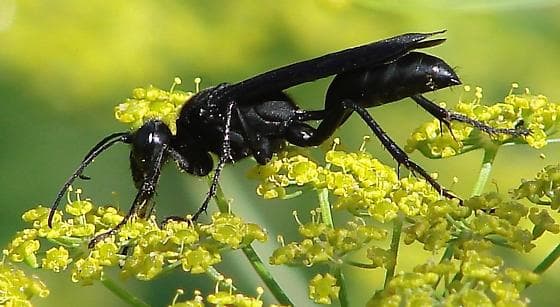
Also known as the great black wasp, this insect can be found in most of North America and northern Mexico and it can get up to one and a half inches in length. It is very large and black in color and the females are larger than the males. It has smoky wings and its sting is very painful. The stings, however, do not make the skin swell as many other stings do.
When the black wasps sting their prey, they always sting a total of three times — once in the neck and twice in the thorax, which paralyzes the prey, although they can survive for weeks this way. After they are stung, the female black wasp usually brings them to the nest for a bit.
2. Black Shield Wasp (Vespa bicolor)
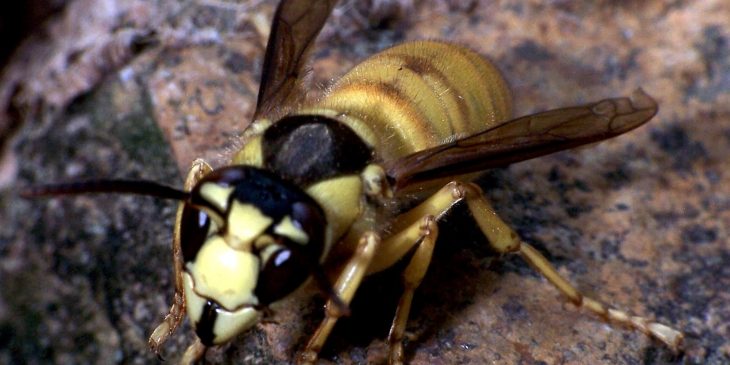
Black shield wasps pollinate orchids and are only found in Hainan, an island in China. It also preys on honeybees and feeds those bees to its larvae. It gets up to roughly 3/4” and is considered one of the smallest of the species. It is a very common social wasp and can often be seen around human dwellings. The black shield wasp has a lot of different prey, including small flying insects, but they also love food, which is why they are often found around outdoor barbecue sites.
This type of wasp is docile and usually won’t sting unless provoked; however, its sting is very painful. Their bodies are usually a combination of dark-brown and a Sulphur-yellow color.
3. Cicada Killers / Ground Digger Wasp (Sphecius speciosus)
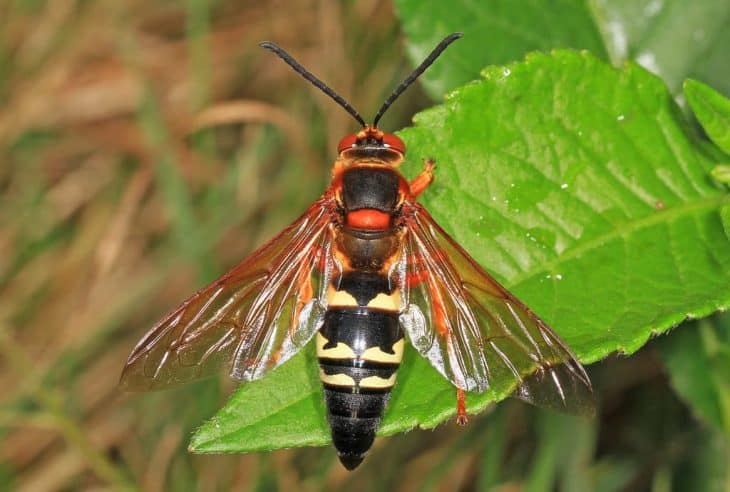
As opposed to nests which hang from eaves or porches, this type of wasp actually digs its nest under the ground. They are usually solitary insects. The ground digger wasp is one inch long with a body that is black and orange-red in color. The cicada killers are black in the abdomen and have yellow markings as well as wings that are orange-tinted.
The ground diggers prefer sandy soil for their nests and they are commonly found near flagstones or patio homes. Their preferred hosts include the long-horned grasshoppers. The cicada killers get up to one and a half inches long and are found east of the Rocky Mountains. Although the latter are great at killing cicadas, their nests can cause damage to the lawn, especially since they can be as deep as 10 inches.
4. Ichneumon Wasps
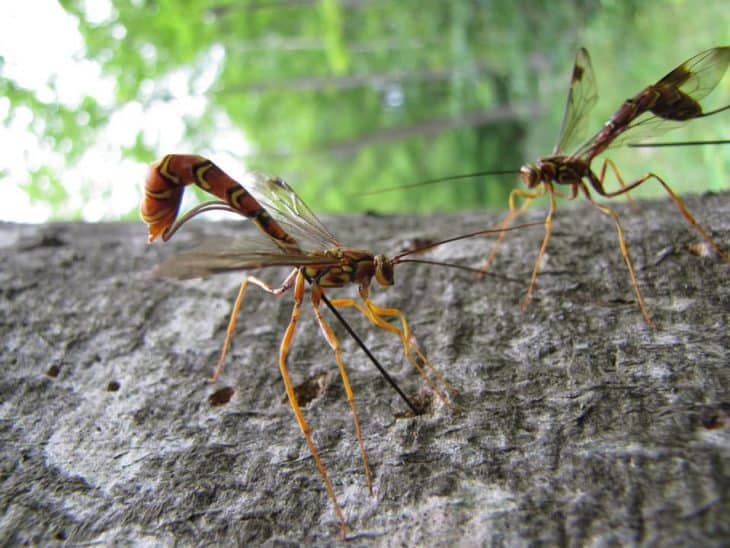
Ichneumon wasps are roughly one and a half inches long and have very long antennas. Their colors vary with some wasps being dark in color and others being brightly colored with patterned bodies. Some even have black and yellow stripes, which make them look similar to stinging wasps. However, most Ichneumon wasps never sting humans, although technically they are able to do so.
One of the assets of these types of wasps is the fact that they feed on boll weevils, wood-boring insects, and tomato hornworms; therefore, they do a great job of controlling the pest population. The adult wasps feed on nectar, shrubs, and trees and their hosts usually include grubs or caterpillars. Once their young hatch, the female wasp eats its host.
5. Mud Dauber Wasp
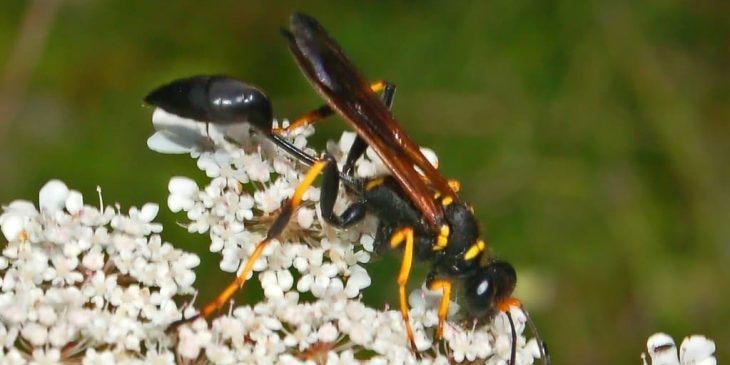
There are three different wasps in this category: mud daubers, pollen wasps, and potter wasps. The mud dauber wasp uses mud and clay to build a nest, hence its name. They get up to one inch long and are solitary insects. They are long and thin and they are often called dirt daubers or thread wasps. Oddly, these creatures are not protective of their nests and therefore seldom sting.
Mud dauber wasps prey on all types of spiders, including the black widow spider, and they often attach themselves under porches or eaves as well as in attics and walls. Their nests hold up to 20 wasps and have cells in the shape of tubes.
6. Paper Wasp
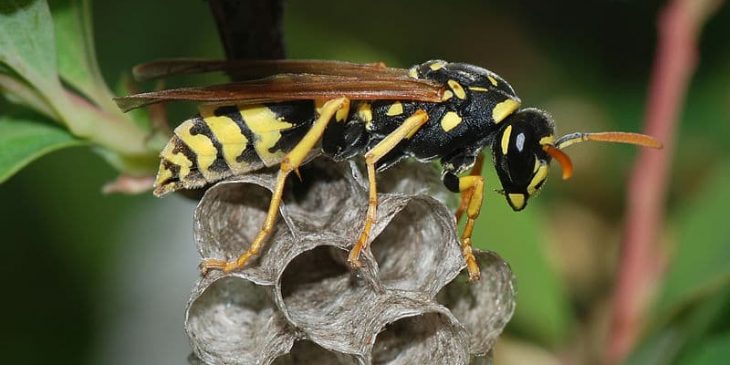
Paper wasps get up to one and a half inches long and are very social with nests of up to 30 wasps each. They are yellow and have stripes of either black or a rusty brown color. They like to be out in the open and can even be found under eaves, although they also congregate in trees and attics. Their sting is very painful but they can sting without losing their stingers.
Paper wasps only attack when they feel threatened, especially if they feel as if their nests are being attacked. These types of wasps are found mostly in the western and southeastern regions of the United States and into Mexico. They get their name because of the paper they usually use to build their nests.
7. Potter Wasp
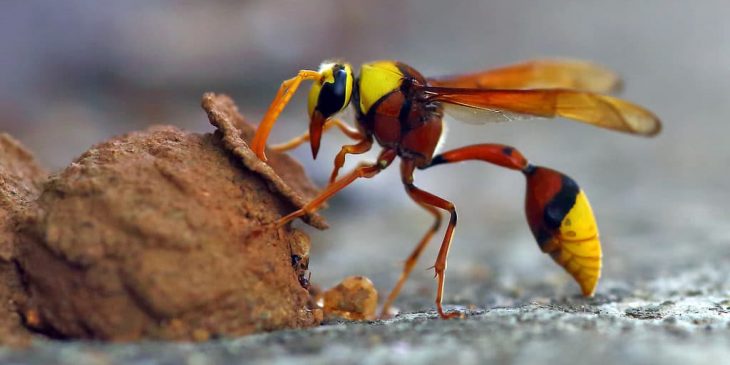
Found mostly in the western and southeastern regions of the United States, potter wasps are very small at only half an inch in length. They are sometimes called mason wasps and they are generally very solitary. Their nests are also quite small, usually smaller than a lemon, and they often have yellow and black stripes on their bodies. There are over 200 groups listed under this species so there is a lot of diversity among this type of wasp.
8. Sand Wasp (Bembicini)
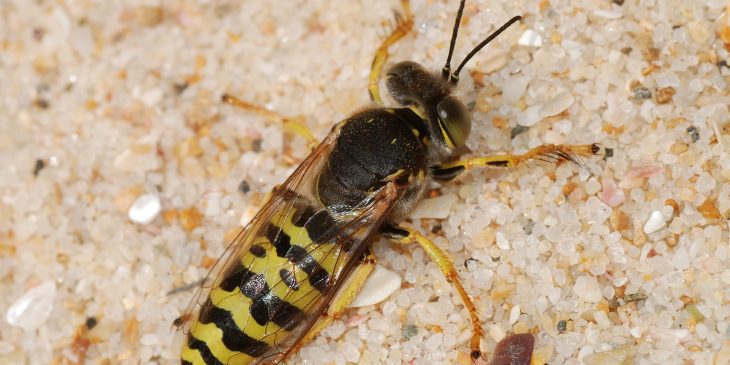
Coming from a large tribe of about 20 genera, the sand wasp is usually yellow and black in color but some of them are black and white and have bright green eyes. Their prey includes various types of insects and their nests are usually very simple and short. Oddly enough, the sand wasps sometimes prey on their own parasites, which is nearly unheard of in the animal kingdom.
Sand wasps are solitary and usually grow to about one inch in length. Their elongated upper lip makes them appear to have beaks and they usually create their nests in the sand.
9. Spider Wasp
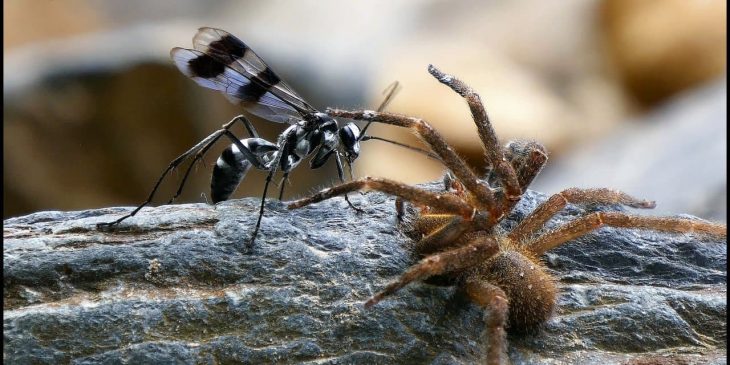
Spider wasps are part of a species of 5000 members under six subfamilies. All spider wasps are solitary and most of them capture and paralyze their prey. They have bodies that are usually dark blue or black in color and some of them merely look like large flies. There are also many species that are brightly colored instead. You can find spider wasps throughout most of the world.
The adult spider wasp feeds on nectar and various plants, most often the eucalyptus plant. They do sting and their sting is extremely painful and powerful; in fact, only one other insect — the bullet ant — has a sting that is worse.
10. Tarantula Hawk Wasp
The tarantula hawk wasp is a type of spider wasp that hunts tarantulas. They sting and paralyze their prey before bringing it into their nest and feeding on it. They can get up to two inches long and usually have bluish-black bodies and brown-colored wings. Their long legs make catching their prey a little simpler and their stings are considered one of the most painful types of stings in the world.
Tarantula hawks can be found all over the world, including Europe, Southeast Asia, and the Americas. Even though their sting is fierce, they are fairly docile insects and seldom sting unless they are threatened
11. Yellow Jacket
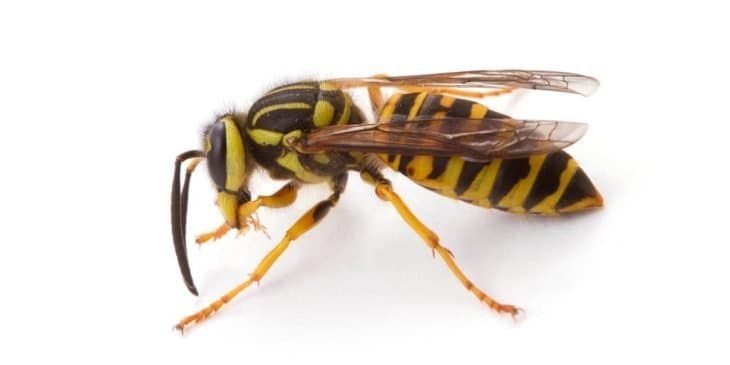
Yellow jackets are roughly one-half inch in length and are very social. They are found mostly in the United States and Canada and they are often mistaken for honeybees. If you’re curious to determine if you’ve located a yellow jacket, look for its side-to-side flight pattern just before it lands. Their color is a bright yellow as opposed to the more orange color of honeybees and they do not carry yellow pollen or forage on flowers.
Yellow jackets can sting repeatedly but never lose their stingers. They only sting when they feel threatened or sometimes by accident. Their nests can get up to 5000 members each.
12. American Pelecinid Wasp (Pelecinus Polyturator)
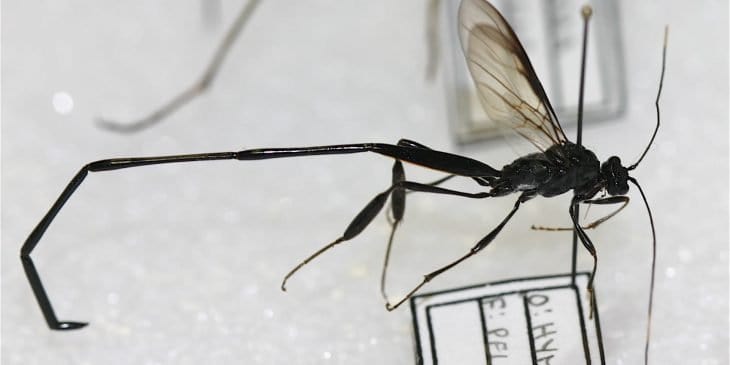
A large black, glossy-looking wasp, the American pelecinid wasp lives mostly in the woods and crop fields, although they can be found in some suburban gardens throughout the Americas. Both mysterious and eye catching, the female wasps are the most common and in fact, some have speculated that it is possible for them to reproduce without males. Its long abdomen is used to deposit its eggs into grubs’ backs while they live underground, and they are commonly seen from mid-summer to early fall.
13. Banded Horntail (Urocerus Gigas Flavicornis)
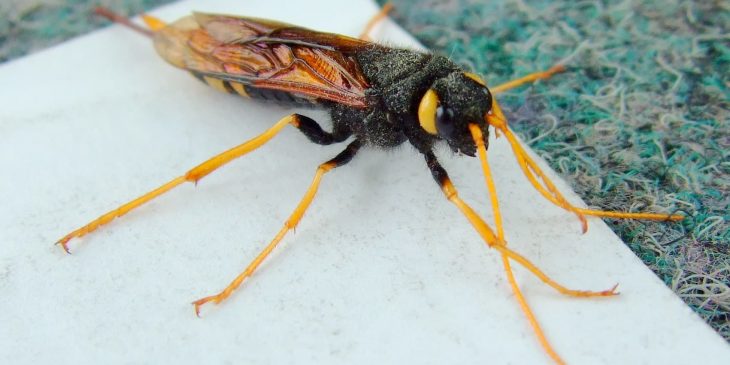
Also called a wood wasp, this type of wasp has around 150 species and are usually brown, black or blue in color with yellow parts. The adults can grow up to 1.5 inches in length, and they can infest both broad-leaved or needle-leaved trees. The wasps’ abdomen has a long spike that projects outward, and the females lay their eggs in trees. They have a fairly passive nature, even though they can look quite threatening.
Types of Hornets
The terms wasp and hornet are often used to describe the same insect. There is no clear distinguishable fact that makes one a wasp and the other a hornet. All hornets are in fact wasps. In general, hornets are larger and perhaps more menacing than wasps. Down below are 12 types of hornets. Most of these are not common in the US, thankfully…
Related: What do hornets eat?
14. Asian Giant Hornet (Vespa mandarinia)
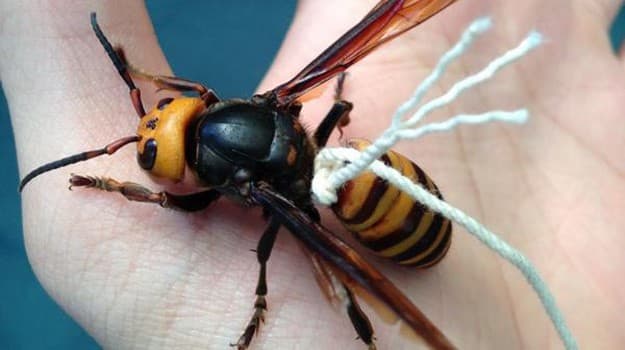
Also known as the yak-killer hornet, the Asian giant hornet is considered the largest hornet in the world at nearly two inches in length. Its wingspan is roughly three inches, and it has a stinger that is roughly one-quarter of an inch long. It is native to eastern Asia and prefers to live in forests and low mountains. It has a light-orange head, brown antennas with a yellow-orange base, and dark brown or black eyes.
Asian giant hornets are found in areas such as Korea, Taiwan, certain parts of Russia, Nepal, and Sri Lanka, among others. They are not found in the United States.
15. Bald-Faced Hornet (Dolichovespula maculata)
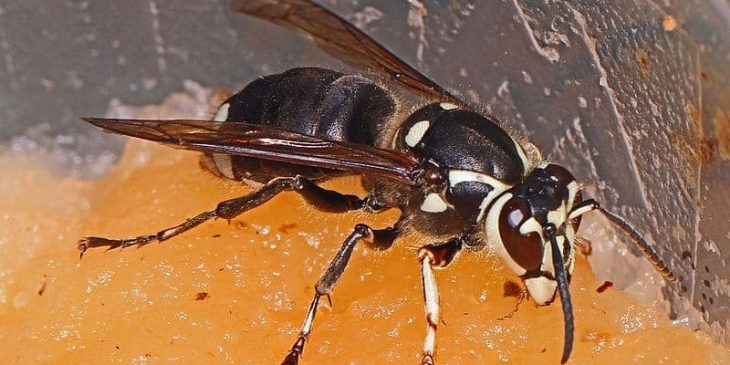
Bald-faced hornets are characterized by their black color and either white or yellow stripes. They are very social creatures and get up to two inches long. Longer and thicker than a yellow jacket, the bald-faced hornet builds large nests that can be the size of a football, which are frequently located in tree branches and bushes as well as attics and wall voids. They are most common in Canada and the northeastern part of the United States.
It is possible to have an overabundance of hornets in or around your home that may require professional removal. In fact, you should never try to remove a hornet’s nest without professional assistance.
16. Black-Bellied Hornet (Vespa basalis)
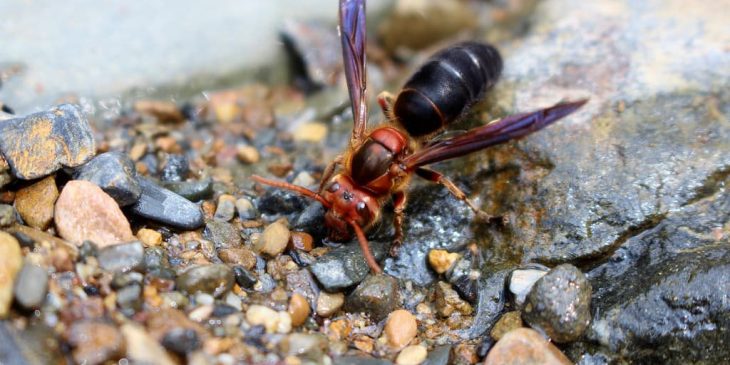
Native to Taiwan, the black-bellied hornet has colonies that can contain as many as 5000 hornets. They are considered one of the most dangerous types of hornets, in part because their sting is very painful and results in a lot of swelling. Its venom can even cause cardiovascular problems. It is also found in the state of New York in the United States.
17. Black-Tailed Hornet (Vespa ducalis)
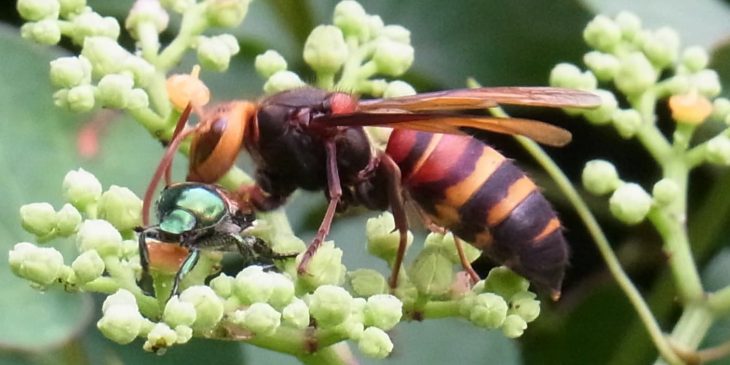
First described in the 1850s in Japan, the black-tailed hornet can grow to approximately one and a half inches in length. It is common in most parts of Asia, including China, Hong Kong, Thailand, Nepal, and Vietnam, among others, and it has a very distinctive black tail, hence its name. The translation of the name means “princess sparrow bee” and their underground nests typically have around 50 hornets each.
Black-tailed hornets are docile and rarely show any type of aggression even when provoked and they also have a very short life span. The queens start their nests in mid-May and they all start to die off around September.
18. European Hornet (Vespa crabro)
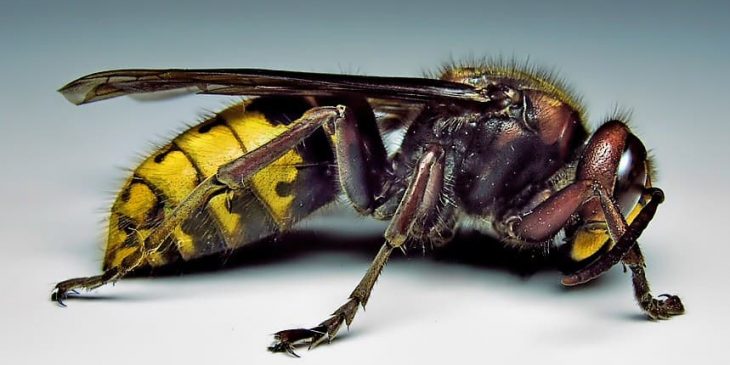
These hornets get quite large, up to one and a half inches in length. They are brown in color and have pale faces and yellow stripes on their abdomens. They can also be called brown hornets or giant hornets and they are even active at night. They can be found in 31 of the 50 states and their nests are commonly found in trees, attics, wall voids, and porches.
European hornets can sting when they feel that they’re being attacked and they can even sting repeatedly, making those stings quite painful. Their nests are usually made out of paper cartons and covered in brown paper envelopes. They are also considered to be beneficial in some instances for pest-control reasons but caution should still be taken if they are found near a structure.
19. Greater Banded Hornet (Vespa tropica)
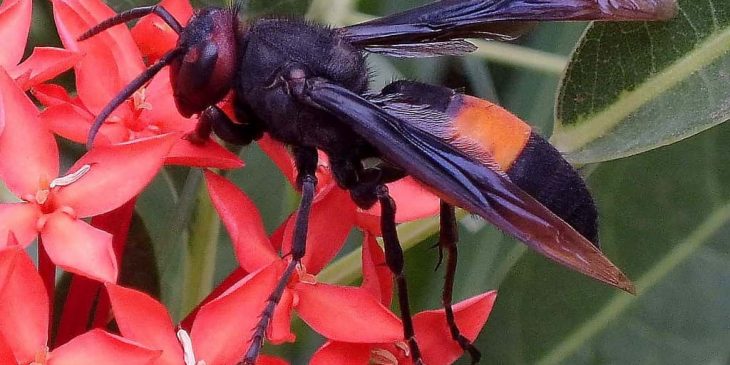
The greater banded hornet is a tropical type of hornet and it is found only in southern Asia, west Africa, Guam, and New Guinea. It is a predator of the paper wasp and it is roughly one inch long. It has a brownish-red head and a black abdomen with a very distinct yellow stripe. They usually construct nests underground or in tree hollows or other enclosed spaces.
Although this type of hornet is not that aggressive, it does have a very painful sting; in fact, those stings have actually killed people.
20. Japanese Yellow Hornet (Vespa simillima)
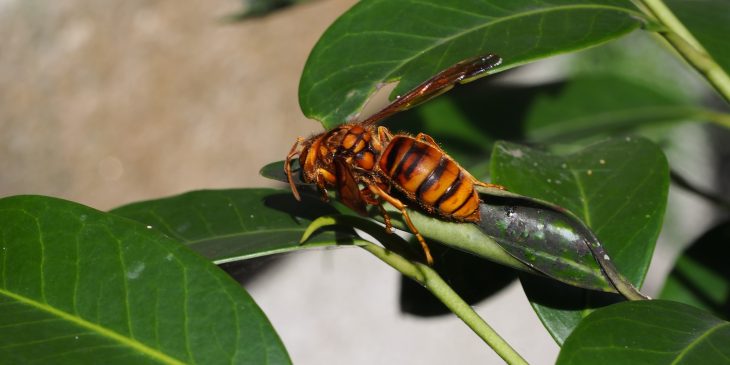
A large hornet, usually getting up to one and a half inches long, the Japanese yellow hornet has a large yellow head, big eyes, and a body that is dark brown with brown and yellow bands. It is endemic to Japan and feasts mostly on numerous insects, which makes it very beneficial in protecting crops. In some of the mountain villages in Japan, this type of hornet is actually considered a delicacy.
The Japanese yellow hornet is an aggressive insect and has venom that can damage your tissues and the nervous system. In fact, these hornets can be lethal in both those who are allergic and those who are not. However, they normally only sting when they feel threatened.
21. Lesser Banded Hornet (Vespa affinis)
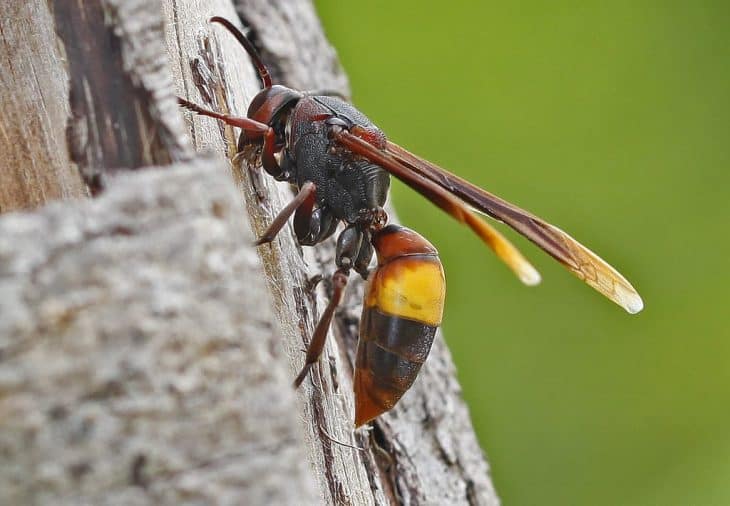
The lesser banded hornet gets to approximately one and a half inches in length and it is usually deep black with a band of yellow. Some, however, are fully black in color while others are black with a bright-orange band instead of a yellow one. Found frequently throughout Asia, this type of hornet preys on flies and other pests and they love the nectar found in the flowers of the coconut tree.
Their nests can be found in many outdoor places, including tall trees and even around homes. In areas such as Hong Kong, they start to die out in late November or December after the queen awakens from hibernation in April.
22. Oriental Hornet (Vespa orientalis)
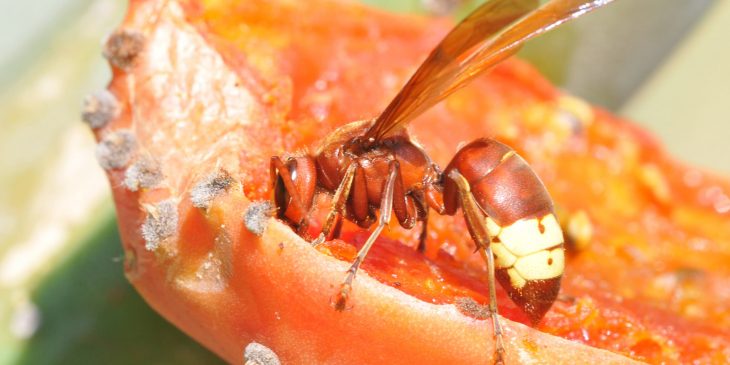
This is a very social insect found in various places, including Madagascar, southwest Asia, northeast Africa, and parts of southern Europe. They have a caste system and live in seasonal colonies. They are also scavengers; therefore, they sometimes transmit diseases because of infected plants that they’ve eaten.
They are pests to honeybees and even attack the honeybees’ nests in order to get animal proteins and honey. When they sting, it is very painful; d in fact, many people are allergic to this type of hornet. They have two pairs of wings and the males and worker bees are all smaller than the females.
23. Vespa Luctuosa
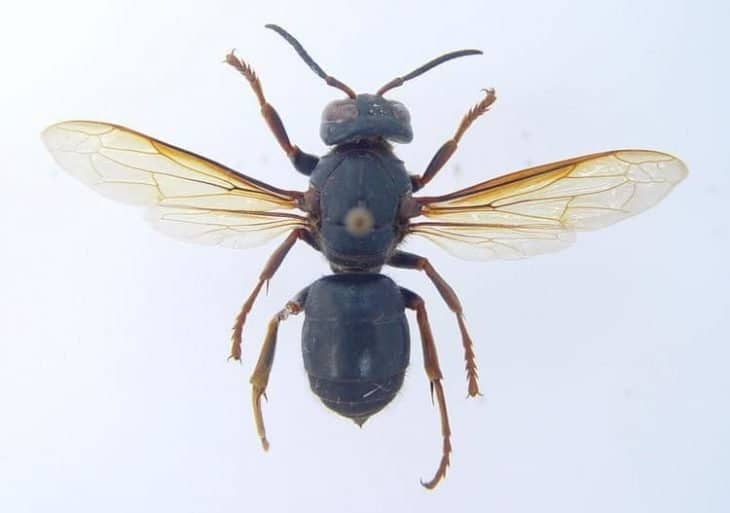
Endemic to the Philippines, this type of hornet is known for its extremely toxic venom and for the amount of venom found in each sting. In fact, people who are stung by the Vespa luctuosa can experience symptoms such as discoloration of the skin, convulsions, and red or brown discoloration of the urine.
These hornets usually build nests that hang in bushes and trees. The nests are spherical at first and later become more elongated as they age.
24. Vespa Soror
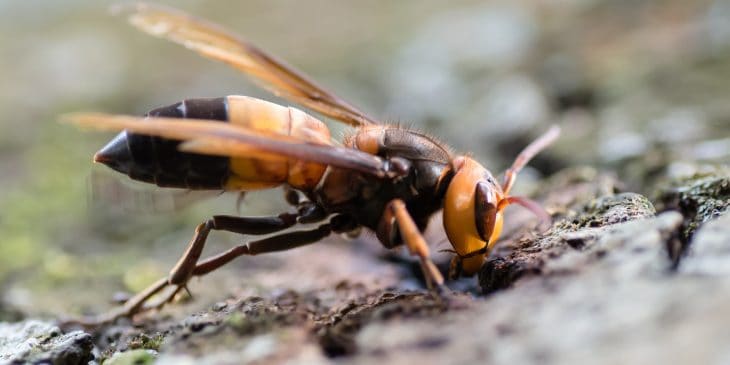
The females in this group can get to nearly two inches long, making them quite intimidating, although the males are a bit smaller. They have jaws that are very strong and powerful. They are usually black in color with orange markings. Found in areas such as Hong Kong, north Thailand, and south China, they are reluctant to fly around people because they prefer more rural areas.
Extremely predatory, the Vespa soror will frequently attack large butterflies, grasshoppers, large spiders, and even dragonflies, usually killing them. Their large size gives them the confidence to do things such as this so they are extremely dangerous to those animals.
25. Yellow-Legged Hornet (Vespa velutina)
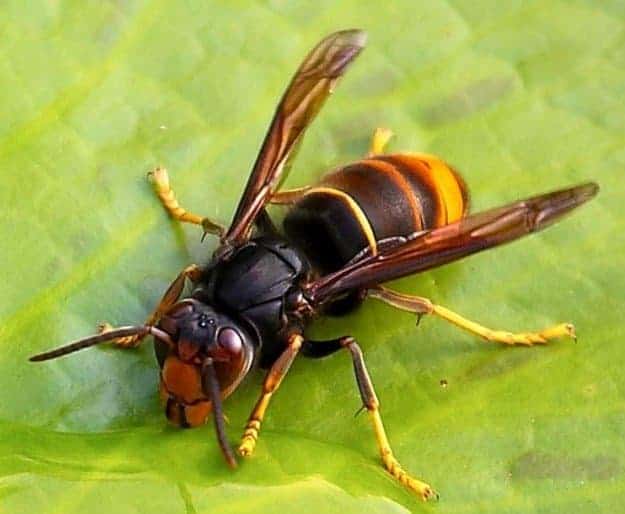
Known also as the Asian hornet, the yellow-legged hornet is indigenous to Southeast Asia. Its legs are a distinctive yellow color and it typically gets no longer than one inch in length. Several thousand hornets can live in their nests, which are usually made of paper and resemble a large egg. They have a long nesting season and they will defend their nests when necessary with their stingers.
These hornets exit their nests laterally instead of through the bottom and their prey includes animals such as dragonflies, flies, crickets, and locusts. Most tropical regions of Southeast Asia contain this type of wasp.
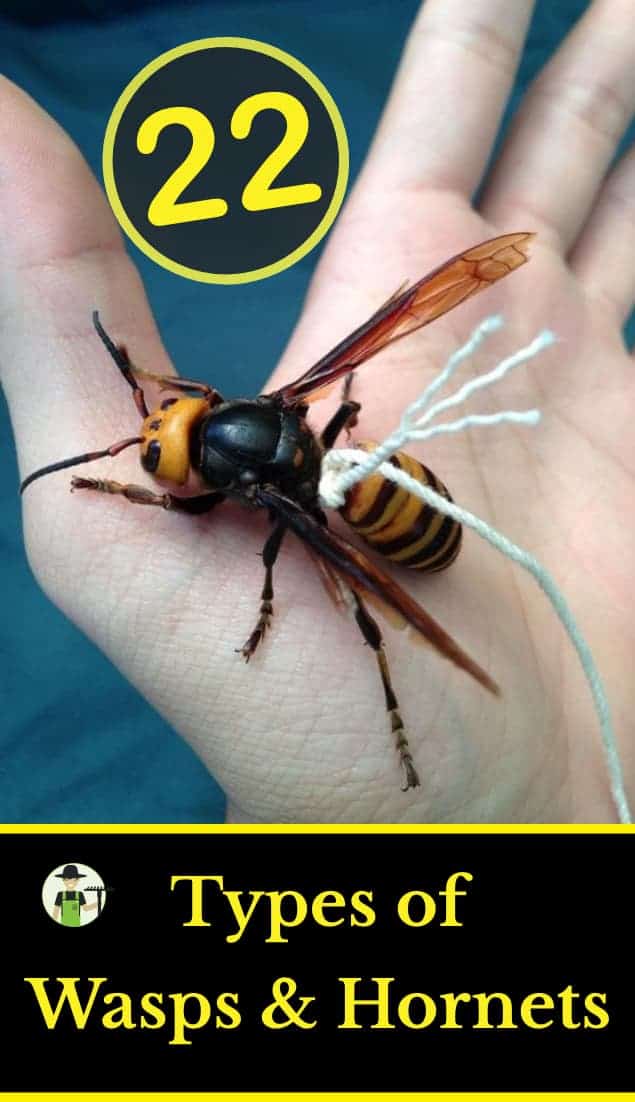

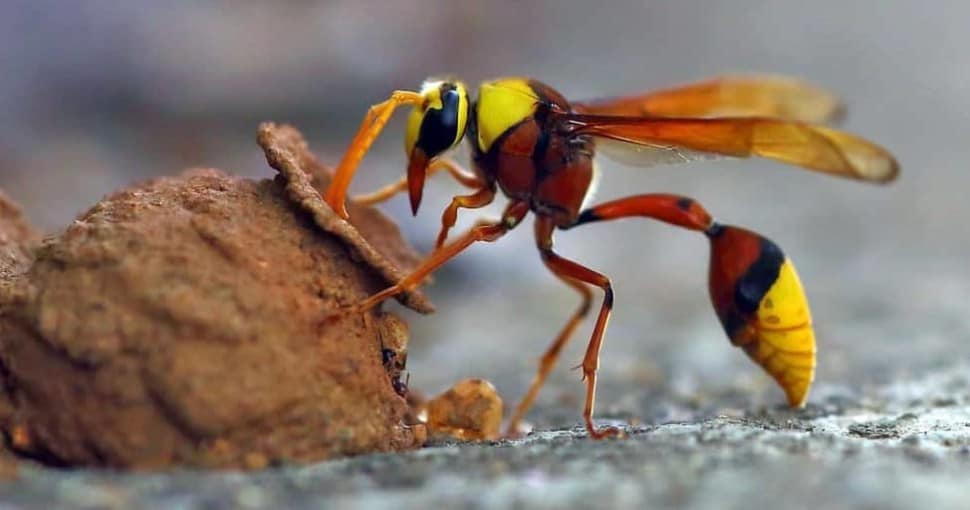
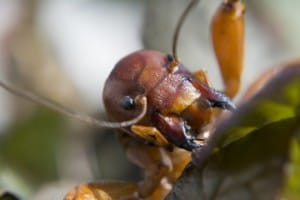
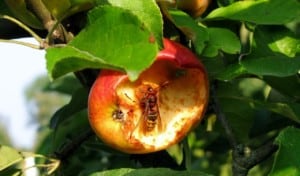
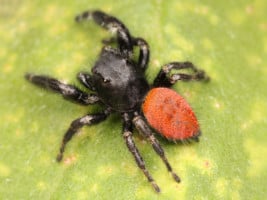
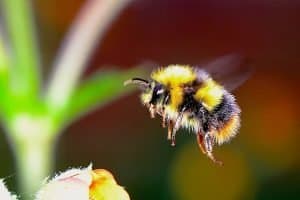
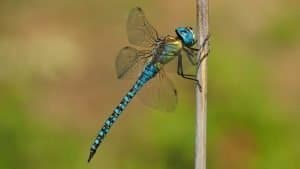
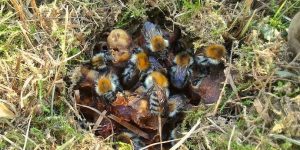
i saw orange and black striped fat tail hornet in nottingham maryland 21236 they are here